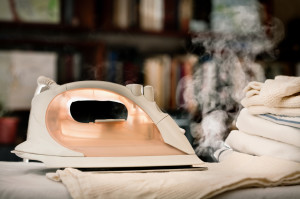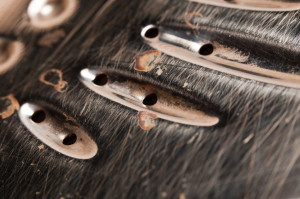 Do you remember your grandmother’s steam iron? I remember mine. She handed it down to my mother and it was the first steam iron that I ever used. While I have fond memories of that iron, there is no way that I could go back to it.
Do you remember your grandmother’s steam iron? I remember mine. She handed it down to my mother and it was the first steam iron that I ever used. While I have fond memories of that iron, there is no way that I could go back to it.
You might not think that there is much room for technological advancement in the steam iron world, but today’s steam irons really can do so much more than their predecessors and are available with as many or as few features as you need.
This page is dedicated to explaining all of the parts and features so that you can decide which steam iron is best for you.
Power and Heat
Wattage
Do more watts mean a better steam iron? Not necessarily, but there is a bit of a range that I like to stick to. I find that some irons have too much power for home use, and others don’t have nearly enough.
While a steam iron with a higher rating will mean that there is more power available to quickly heat up your soleplate and keep it hot, the average person probably doesn’t need much more than 1800 watts.
On the other hand, too little power is a problem. Using a steam iron that has less than 1000 watts may mean that the iron will cool off much more quickly. If it cools off too quickly, it will need time to rest and come up to temperature again. This translates into fewer strokes on your clothes at a time, more time spent going over each section, and more time standing around. It’s also a possibility that steam irons with lower wattage it might not reach temperatures high enough to handle tough wrinkles.
And while using an iron that uses less energy may seem like a way to save on your power bill, know that you may spend more time ironing, negating any potential savings.
All things considered, a good iron with plenty of power will help you to finish your ironing with less work, and less waiting.
Heat Settings
Most modern irons have fabric settings built right into the temperature settings, but always check to make sure. Even if it doesn’t, it should at the very least have a fabric guide printed on the body somewhere.
It’s also a good idea to take a look at how many settings there are. Keep in mind that the more settings an iron has, the more control you will have over the heat.
Auto off
 Think that auto-off is a safety feature built into every iron? Think again.
Think that auto-off is a safety feature built into every iron? Think again.
There are several models available with no such feature. There are some legitimate reasons to intentionally buy a model with no auto-off. If you like to sew or quilt and want a constantly hot iron available at all times. When higher-end manufacturers design a new model, it’s usually an auto-shutoff model but they’ll often make a sister model that doesn’t include it specifically for people who don’t want it.
Lower-end models are a different story. Some have them, and some don’t.
If you want the comfort of an iron that will safely shut itself off, make sure to check the product information to see if it’s included. Even if it is, take a really good look at what the auto-off function of a steam iron can offer you because there are major differences.
Steam irons that have an auto off feature run on a timer and a motion sensor. Most models have sensors that use mercury and work like an old-style thermostat. The mercury moves around to create a connection and keeps working. If the mercury doesn’t make that connection, the iron will eventually turn off. If you want to avoid anything with mercury, there are a few models out there that are mercury-free. See my Panasonic NI-E300TR review for an example.
Also pay attention to how the auto off timer works. Most work like this: You walk away from your iron for a short period of time – usually around 8 – 10 minutes, and it will cut power to the heating element, only to turn on again when it senses it’s been moved.
Some will even shut off after a minute or less if it senses that it’s on its side or soleplate, but not all! If this is a feature that is important to you, make sure you understand how it works before you buy, and never rely on it to save your clothes or flooring.
Steam
Constant Steam Output Settings
If you have a lot of different materials that you iron regularly,consider a steam iron with several output settings. These settings will give you more control over how much steam is released from the soleplate as you iron your clothing. Do you really only iron suits, dress shirts and jeans? A steam iron with simple high and low settings should be enough. If you iron more than just a few basic materials, more steam output settings will be helpful.
Spray Nozzle
A spray nozzle to spritz your clothes is standard on all models these days, but even two steam irons of the same model might not spray exactly alike. I really don’t put much stock into how well or how poorly the spray function performs, as it seems to be pretty random regardless of which model you choose. My opinion is that if it works like it should, great! If not, pick up a spray bottle from the dollar store.
Steam Burst
Many steam irons have a steam burst feature, but not all. This is my go-to feature when I need just a little extra moisture to help attack stubborn wrinkles. Ever leave a pair of jeans in the dryer that haven’t completely dried? A steam burst button is your best friend!
Vertical Steam
While I only find myself using this feature once in a while, it sure does come in handy. A steam iron that can steam vertically is wonderful for taking light wrinkling out of hanging clothes, and is perfect for relaxing wrinkles in curtains or drapes.
If this is a feature you feel need, make sure to look for an iron that has a higher watt rating as it will give you more steam before it needs to reheat. It will warm up more steam for you much faster, too.
Sole plate construction
Thickness
I remember the first time I ever picked up an expensive steam iron in a department store and tapped the soleplate, only to find out that it didn’t feel thick and heavy as I had expected. I learned later that there is a reason why: a thinner soleplate is usually a sign that it has been designed to transfer as much heat as fast as possible.
That doesn’t mean that a thicker soleplate is necessarily bad; it’s just not as good. Higher-priced steam irons often have have thin soleplates Thin soleplates are u If you can afford it, go for it. If not, don’t worry about it.
Material
 What’s the best type of material for a soleplate? Though there is a general consensus that aluminum is probably not the best, there have been some fairly strong opinions between the others. I’ve made some notes below on each of four popular materials for you.
What’s the best type of material for a soleplate? Though there is a general consensus that aluminum is probably not the best, there have been some fairly strong opinions between the others. I’ve made some notes below on each of four popular materials for you.
Non-stick Coating
I’m not a huge fan of non-stick, because they scratch easily and they don’t glide as nicely as ceramic or stainless steel. When they have a few scratches, they’re suddenly not at all non-stick. Non-stick steam irons also often have a thicker soleplate, which isn’t very efficient at transferring heat. If you think you need a non-stick surface on your steam iron, make sure that it has a higher wattage rating.
Aluminum
Not to be confused with an aluminum core, this is what’s often found on many lower priced steam irons. Aluminum soleplates have to be quite thick and aren’t as efficient as other soleplate type. They don’t glide as well as other types, and they tend to gum up pretty quickly, requiring more cleaning.
Ceramic
Ceramic will glide the best over most materials and is very easy to keep clean. They transfer heat fairly well, but stain very easily. The bonus is that they don’t scratch easily.
Stainless Steel
This is by far the best material for heat transference. They will scratch over time, but it takes a lot of scratching to affect its performance. If you like to press perfect creases into your pants and shirts, look no further.
Steam Holes
Do you need loads of steam vents to get the most out of your steam iron? That depends on how you want to use it. If you are looking at a steam iron with vertical steaming capabilities, then a good soleplate loaded with steam holes throughout is not a bad idea, but for regular ironing, even a few well-place steam vents are usually more than enough. Those looking to spend less needn’t worry about missing out on an extra 300 steam vents!
Lip
If the soleplate meets the body of the iron with no gap, it’s not going to help you smoothly glide around buttons and get up against seams. What should you look for? A sharp angle on the edge, or a tightly rounded edge followed by a little bit of clearance.
Shape
Yes, even shape matters. A poorly shaped soleplate will cause those tiny little wrinkles we all love to hate.
Some steam iron manufacturers have gone above and beyond to balance the soleplate in ways that reduce these tiny little annoyances. Some include an oblong tip that works really well for getting into corners and around buttons. Other steam irons have soleplates that have a slight curve to the base to change where the iron’s center of gravity falls
Do these design features help? Absolutely, but are not at all necessary. What you should really look for is a steam iron with no sharp corners except at the tip. Look for well-rounded corners at the bottom of the soleplate.
Cord
You might not think that a cord is an important steam iron feature, but trust me on this one. I found through trial and error that if the cord isn’t just right, it can wreck your entire ironing experience.
Is the cord long enough?
This might not seem like a big deal, especially if you don’t mind using an extension cord, but this is a sticking point for some people. Cord lengths vary from brand to brand, though most are at least 6 feet long and sometimes as long as 10 feet.
Look for a ball joint at the base
Some steam irons don’t have this, and I’m going to tell you why I feel this an important feature. If the cord sticks straight out of the iron, it’s covered by a protective jacket that is not very flexible and forces the cord to stick out for a few inches.
This is by design; it’s meant to protect the cord and connection from wearing out. The problem is that this style doesn’t allow you to direct where you want the cord to go.
A ball joint that swivels, on the other hand, can easily be pushed from side to side as you like. Take a look at my Black & Decker Digital Advantage Review to see what it looks like.
Retractable Cord
Another option available on a few models is a retractable cord. This is my preference, but I found that while it makes storing the cord a breeze – no wrapping or bundling – most models are designed with the cord intake on the right side of the steam iron. As far as cord control is concerned, a ball joint is still better.
Left-handed people will take issue, as the cord reel is usually found on the side of the iron that faces away from us ‘righties’ when we’re ironing.
An example of a steam iron with a retractable cord can be found here.
Cordless Steam Irons
There are also models that come cordless. At this time, I have not played with one, but I have heard that they tend to run out of power quickly and need to be recharged often. When I get around to testing cordless irons, I’ll update this section.
Special Features
Auto clean
An auto-clean function can help to keep an iron at peak steam performance. Over time, steam vents can become clogged with a mixture of mineral buildup and lint. A steam iron with an auto-clean function can help to keep those vents clear.
Auto lift
This is a feature that I haven’t yet had the pleasure of using, but I definitely plan on testing a steam iron that has it soon.
What makes this a feature worth looking at? It has extra little feet that, when you let go of the iron, will push the soleplate up off of your clothes or ironing board.
It might not sound like much, but if you have any shoulder or neck injuries, this will take out some of the twisting motions regular irons require.
Which Steam Iron is Right for Me?
Yes, there are a lot of features and other considerations that many of us probably don’t need, so what’s the bottom line?
It really depends on your budget and what your personal needs are. Keep in mind that any extra features that you might like, such as vertical steam capability or a retractable cord, will often increase the price.
For most of us, an iron that can provide a good amount of heat and steam is all you need.
Do you need a little help getting started? Check out my steam iron reviews category to see every steam iron I’ve ever reviewed!
